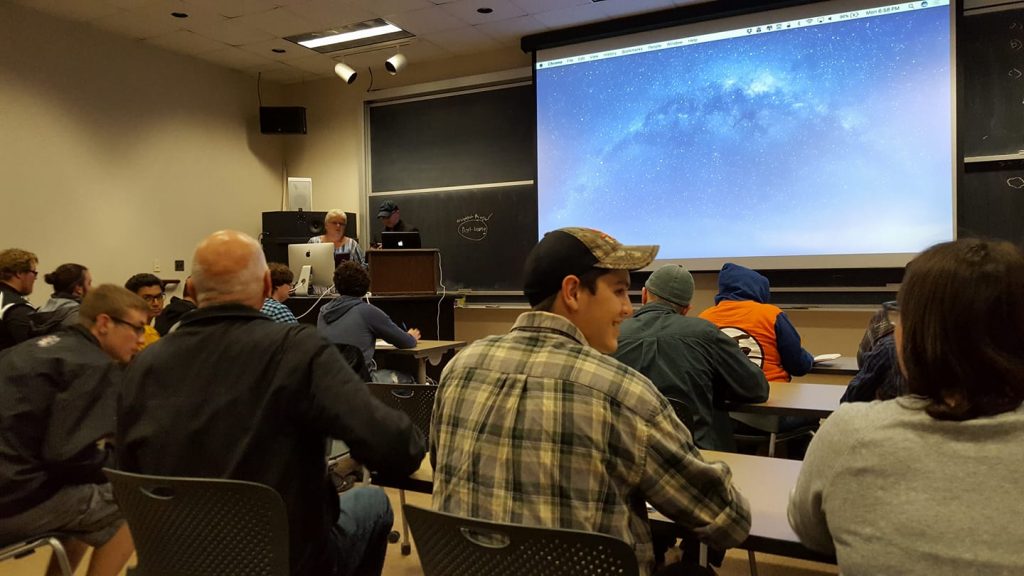Members of the Scientific and Technical Communication Advisory Board visited the Humanities Department on Monday, Sept. 18. The visit is an annual activity that the board undertakes to meet and evaluate the activities of the program. This year they held two public events, dinners, lunches and interaction with undergraduate and graduate students.
The members of the board who visited were Jonathon Colman, Product UX + Content Strategy, Facebook; Sean Fernstrum, President, R.W. Fernstrum & Company; Evelyn Helminen, Middlebury Institute of International Studies at Monterey; Ann Kitalong-Will, Executive Director, Business Operations, Michigan Tech; Monica Lester, Technical Writer, M. J. Electric; Nick Rosencrans, Usability Consultant, University of Minnesota; and Bryant Weathers, Gift Planning and Donor Communications Specialist, Michigan Tech.
On Monday a lunch was held in the Petersen Library of the Humanities Department. At 7:30 p.m. of the same day Jonathon Colman delivered a talk on the topic “Wicked Ambiguity.” Attendance to this event was so large that many participants had to stand outside of Walker 134. In his talk, Colman attempt to answer two questions “How do you solve the world’s hardest problems? And how would you respond if they’re unsolvable?”
“In 1973, the social scientists Horst Rittel and Melvin Webber coined the term ‘Wicked Problem.’ They found that wicked problems are prohibitively expensive to take on, they’re impossible to test, and the symptoms and factors of every wicked problem are, in fact, wicked problems themselves,” Colman said.
Coleman gave examples of “Wicked Problems” that the world had faced and attempts that were made at solving them. “Take last year’s Ebola outbreak in West Africa, which later spread to many countries all over the world, including this one. There’s no simple solution here. As population increases, as resources become scarce, as wars break out, people are forced into developing lands that were once wild. And sometimes, they find disease waiting for them,” he said.
He also used the ongoing War on Drugs as an example of a wicked problem. Although it seems that a militarized solution is being undertaken to solve the problem, Colman recognized that “we’ve made little progress in our global War on Drugs, curtailing neither drug trade nor use. But we’ve spent billions if not trillions of dollars trying. Worse still, we’ve imprisoned millions of people for what are largely non-violent, victimless crimes. These seized bricks of cocaine represent the smallest portion of the drug’s manufacturer, trade, distribution, and use. All tactics, no strategy.”
According to Colman, wicked problems are laden with ambiguity and technical communicators can only solve them when they “Start by being open and direct. When you can acknowledge the presence of ambiguity in your work, you help others recognize it as well. Don’t let it go unspoken. Instead, be up-front—let people know that you sense the strangeness, too”. He also reiterated that we can “make the most progress in our encounters with ambiguity, our accountability must always be counter-balanced by empathy.”
There was also a workshop on Tuesday, Sept. 19, on the topic “Speaking Your User’s Language,” a discussion of plain language, voice, and tone, by Nick Rosencrans, Usability Consultant at the University of Minnesota.
Director of the STC program, Professor Karla Saari Kitalong applauded the success of the visit saying there were “many handshakes and high-fives, a few precious hugs, and loads of positive feedback.” Veena Namboodri, a first-year Ph.D student in the Department of Humanities said the visit accorded students “a chance to have conversations regarding the future career prospects in scientific and technical communication.”





